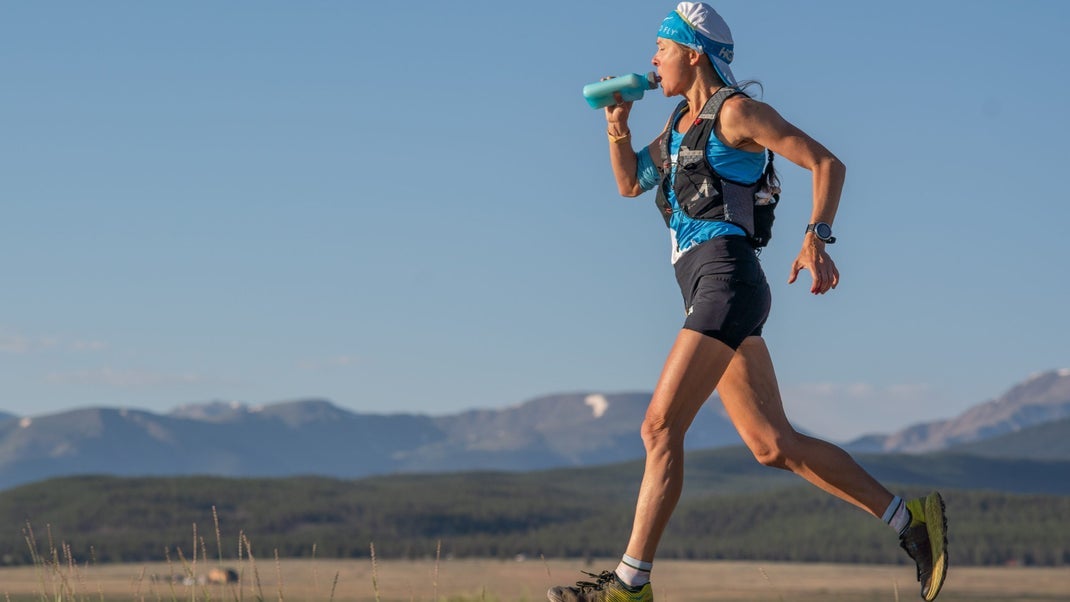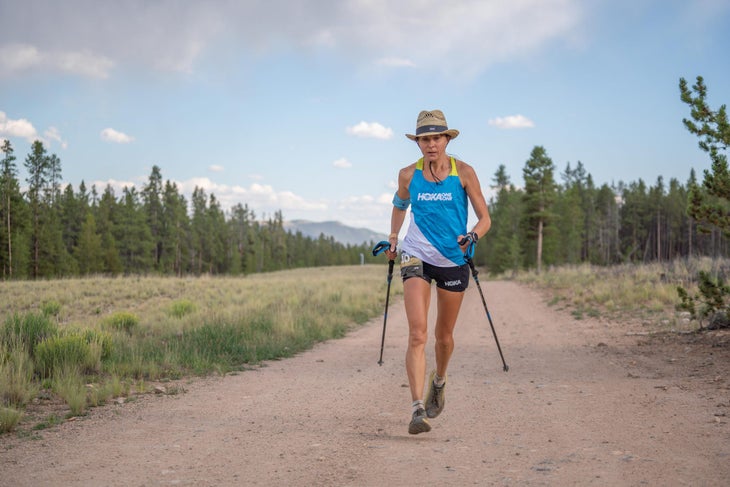Magda Boulet Is Western States Ready

Pro runner Magda Boulet has worn many hats in the running industry. After wrapping up her professional road endeavors a few years after representing the U.S. in the marathon at the Beijing Olympics in 2008, she started dipping her toe into trail endurance events—and it didn’t take long for her to get hooked. Boulet won the 2015 Western States Endurance Run in her first time attempting the 100-mile distance. She’s since topped the podium at the legendary Leadville 100, the Nine Dragons Ultra in China, and the Marathon des Sables, a six-day 155-mile race across Africa’s Sahara Desert, all of which have helped etch her reputation as one of the top female ultrarunners in the country.
Boulet, 47, who currently lives in Oakland, California, was born and raised in Poland and became an American citizen in 2001. In addition to her ultrarunning, she also currently balances a full-time job as GU Energy Labs’ senior vice president of innovation, research, and development; is a mom to her 16-year-old son, Owen; and coaches a few athletes on the side. As she gears up for her third go at Western States on June 26, Boulet talked to Women’s Running about how she manages to fit it all in, her goals for this year’s Western States Race, and how she hopes women’s running as a whole will improve and grow as time goes on.
RELATED: The Western States 100 is back and it’s going to be HOT!
Women’s Running: This year’s Western States Endurance Run will be your third time lining up at the iconic event. What are your goals for this year’s race?
Magda Boulet: My goals for this year’s race are similar to my goals for any race that I show up to the starting line, which is to compete to the best of my ability and take care of the things that I can control. This year’s women’s field is the strongest I have seen in years, and I would be happy coming in the top 10. But, as we all know, anything can happen to anyone over the course of 100 miles, and no matter how the race unfolds, with everything that’s gone on this past year, I am looking forward to crossing that finish line more than any other year.
WR: You’ve been at the trail running and ultra game for nearly a decade now. What made you decide to make that move from road running?
MB: The main reason I ran the marathon was because it was the longest event in the Olympics, and like every pro runner, I’d always dreamed of being an Olympian. After racing on the roads and the track for more than a decade, it was time for me to discover a new challenge. I’d always loved trail running, and I’ve known for a long time that my natural ability is to do better the longer the race is. If there had been a trail ultra in the Olympics, I’m sure I would have crossed over to that corner much, much sooner.
WR: How has the shift to ultra and trail running differed from the intense training that elite marathoning entailed? What have you loved about it and what have you found challenging?
MB: In ultra training, the overall amount of time on my feet is pretty similar to marathon training, but most of the hours are spent during the long, back-to-back weekend runs. When I was running marathons, I’d run about two hours a day on most days, broken up into a morning and evening run. Now I take more rest days, and my weekly runs are closer to an hour, but I’ll sometimes do four to five hours on both Saturday and Sunday. The overall pace is also much slower now and I actively seek out runs with much more vertical gain instead of seeking out the flattest routes possible. I really love the variety of places I seek out for training and the problem-solving aspect of training for trail ultras, which keeps me humble, curious, and motivated year after year.
RELATED: Could 74-Year-Old Eric Spector Become Western State’s Oldest Finisher?

WR: Last fall, you were named to the Western States Endurance Run Foundation Board, alongside Kara Teklinski and filmmaker Billy Yang, a notable move to diversify the organization’s leadership. What are you most looking forward to with this new role?
MB: It’s been such an honor to be selected to participate on the board along with Kara and Billy. I’ve really been enjoying the process and being part of the team that will help guide WSER into the future. I appreciate the opportunity to bring my perspective to the board and race organization, and I hope that my experiences, skillset, and passion for this race will greatly benefit the community and our sport as we work together to deliver on the race’s mission to set the standard for 100-mile runs.
WR: You’re pretty much doing it all, between training for ultra events and working full-time for GU Energy Labs, in addition to balancing your family life. How do you fit it all in?
MB: I have a tremendous respect for everyone who works a full-time job and balances family and training. The support from coworkers, friends, and family are key to making that lifestyle sustainable, as is being creative and adaptable. I’m grateful for the work culture at GU Energy Labs, which prioritizes athleticism and a healthy lifestyle as part of its core values. I am beyond grateful to my coworkers who are always willing to go for a short run or do a core session during lunch and always understand why I’m snacking or eating during meetings.
WR: What are your thoughts on the state of ultrarunning for women in this country?
MB: On the elite side of things, it’s stronger than it’s ever been in terms of depth. I’m still in awe of Ann Trason’s performances from decades ago, when there were hardly any other women in the sport. I was also really excited about Des Linden’s recent 50K world record. While her race technically was an ultra, it was a lot closer to a road marathon than anything else in the ultra world, since it was flat and paved. She’s a big star in the world of road running and she could bring a lot of excitement to trail ultras, and I think she would really thrive as an ultra endurance athlete. She’s smart, tough, and has a stride that I think would transfer well to really long distances. I hope she continues to explore this world of ultra trail running and I think it would be awesome to get to pace her at Western States one day.
RELATED: The Ultramarathon Survival Guide
I would also love to see more fast women cross over from the track and the roads, though it’s a matter of seeing it as a viable option for them and ensuring equal pay for women. We also still have a long way to go though in terms of overall participation, as women currently only account for a quarter of all ultra participants. That number is climbing, but I’d love to see it grow.
WR: The ultrarunning scene has a reputation for being pretty homogenous and largely made up of white men. What do you think can be done to make this community more inclusive toward women and minorities?
MB: There are many barriers to entry into ultrarunning and there are many reasons why I think so few women and minorities participate in ultra-endurance events. Many women and minorities may not feel safe training in places where they live, or their work and family lives may not allow for the time required to train for an ultra event. There are also fewer ultra endurance women and minorities represented in our media, and we all need role models we resonate with to look up to. First, we need to acknowledge the lack of diversity in ultrarunning and the reasons why these barriers exist. Then we need to be intentional about breaking down these barriers and collectively create an inclusive environment where everyone feels they are welcomed and that they belong.
WR: Any thoughts on the upcoming Olympics, particularly the state of women’s running in our country in general compared to when you were competing?
MB: I’m always excited to watch the best in the world compete for Olympic medals. I’m equally excited to watch the U.S. Olympic Track and Field Trials as well, as I have such fond memories of the process that it takes to toe the line of these events. There is so much talent rising to the top in women’s distance running, and I love seeing more training groups being formed in many places around the country that are creating opportunities for women to continue to train after college.
I have especially loved seeing HOKA ONE ONE [Boulet’s sponsor] invest in the Northern Arizona Elite group to create an environment for women to train and compete at the highest level of competition … I’m especially excited to follow Aliphine Tuliamuk, who won the U.S. Olympic Marathon Trials last year and then decided to have a baby after the Tokyo Olympics were postponed. She’ll be competing in the Olympics about seven months after giving birth, and I think that is awesome. I’m going to be so proud to watch her represent our country, not only as an American, but as a fellow immigrant and a fellow mom.
RELATED: Katie Asmuth Prepares To Toe The Line At Western States
WR: On top of all of your other commitments, you’re currently coaching fellow former Olympian Alysia Montaño. How is that going, and what have you enjoyed most about coaching other athletes?
MB: It’s going great. Alysia’s energy is just what I need sometimes when I’m feeling tired myself, and her passion for building other women up and investing time and energy into our community is aligned so tightly with me that it makes our partnership very meaningful and fun. I absolutely love coaching and hope that in the future I can dedicate more time to it, as I can only take on very few athletes right now.
WR: Between your job, your training, and coaching other athletes, you were probably easily able to keep yourself busy during the pandemic. What helped you stay focused with most races being canceled last year?
MB: Keeping myself busy during the pandemic is probably the understatement of the year. Things got really busy for me at work, and it was initially a challenge to find the spaces in our tiny home for everyone to do their work or school and not get in each other’s way, though we eventually figured it out.
As far as races not happening, early on I decided to create some of my own challenges, the most significant one was “Everesting” on foot, first over the course of a week, and then in one single day. That was a challenging feat for me for sure, but I was really proud of my effort, and I got some support over the course of the 18 or so hours of running.
But honestly, the break from competition was good for me. I tend to want to do every race I get invited to, but sometimes it’s better for your body and mind to take a break from the intense training and racing and just recharge, which the pandemic forced me to do. I think as an athlete, I’ll be stronger for it. But that being said, I truly missed seeing friends and fellow competitors, as well as traveling to new places.